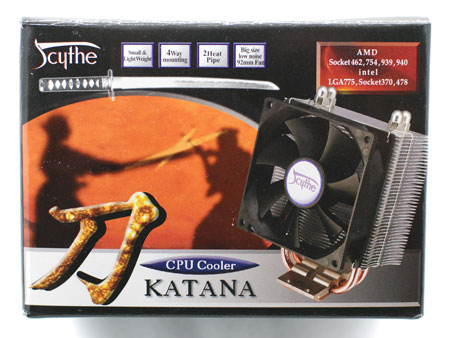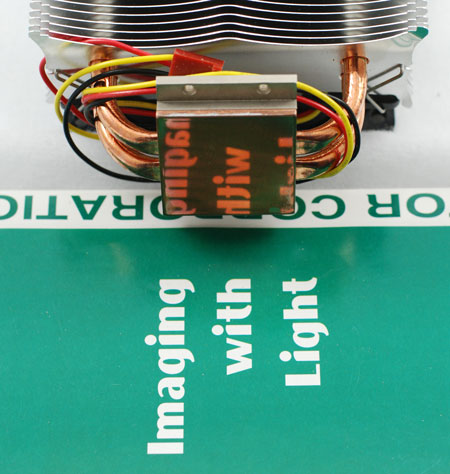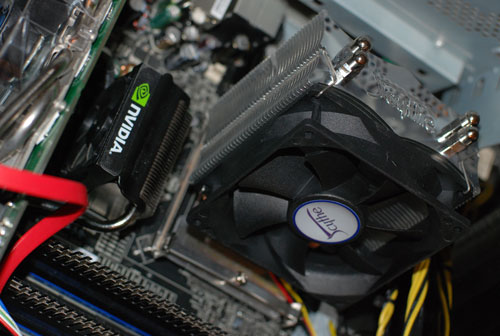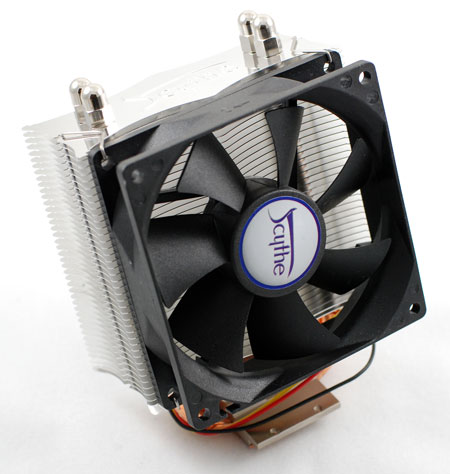Value Cooling: Two Towers for under $30
by Wesley Fink on January 23, 2007 3:50 AM EST- Posted in
- Cases/Cooling/PSUs
Scythe Katana
Scythe produces a wide range of air cooling solutions for the computer enthusiast. There are currently about a dozen air cooling solutions detailed on the company website. These range from entry level cooling solutions all the way to powerful cooling tower designs.
Scythe Co., Ltd is a Japanese company located in Tokyo. Beginning in 2002 Scythe started manufacturing and distributing products for the PC enthusiast, including CPU cooling solutions. Scythe's first product, the Scythe Samurai, developed quite a reputation among computer enthusiasts. Their current catalog includes the well-known full cooling tower solution, the Scythe Infinity.

Scythe likes using full color graphics and Japanese fight themes in their packaging. The Katana is no exception.

While the Thermalright MST-9775 is designed to support just the Socket 775, the Katana includes an incredible array of hardware to adapt it to AMD Socket A (462), 754/939/940, Intel 370, Intel 478, and Intel 775. It should also be mentioned that Katana is one of the few current coolers that actually meets AMD's recommendation of 300g maximum weight for Socket A coolers.

The mounting surface of Katana is highly polished. Many do not believe this matters much on processors with integral heatspreaders like Core 2 Duo, P4, Socket 478 and AM2. However, a smooth mating surface does matter a great deal on small surface area processors like Athlon XP and other Socket A designs.
With Katana supporting so many different sockets, it should be no surprise that some installations are easier than others. Installation on Socket A is a breeze, but Socket 775 installation is a nightmare. The motherboard has to be removed from the case to install the back plate and adapters which basically make 775 into a Socket 478 cage. Then you have to install flat "clips" with a set screw to create the pressure to hold the cooler in place - all while holding the cooler.

The point is the installation is possible, but we could find no way to do it in a case. Install the cooler before remounting the motherboard. The finished Core 2 Duo install took a while, but once it is done properly, the cooler works just fine on a Core 2 Duo processor.

Scythe also suggests that the Katana be mounted so the fan, which blows through the fins/heatpipes, is aimed toward a rear exhaust. This works well in cases with a top-mounted power supply. In designs with the power supply at the bottom of the case a top exhaust should also work fine.
The Scythe Katana uses a large 92mm fan that runs at just one speed - 2000rpm. There are no provisions for variable fan speed, but you can add a fan controller like the Zalman if you want. There is also an upgraded Katana model - the Katana CU - which adds all copper construction and a fan controller to the base Katana for about $15 more (total $40).
Scythe produces a wide range of air cooling solutions for the computer enthusiast. There are currently about a dozen air cooling solutions detailed on the company website. These range from entry level cooling solutions all the way to powerful cooling tower designs.
Scythe Co., Ltd is a Japanese company located in Tokyo. Beginning in 2002 Scythe started manufacturing and distributing products for the PC enthusiast, including CPU cooling solutions. Scythe's first product, the Scythe Samurai, developed quite a reputation among computer enthusiasts. Their current catalog includes the well-known full cooling tower solution, the Scythe Infinity.

Scythe likes using full color graphics and Japanese fight themes in their packaging. The Katana is no exception.

While the Thermalright MST-9775 is designed to support just the Socket 775, the Katana includes an incredible array of hardware to adapt it to AMD Socket A (462), 754/939/940, Intel 370, Intel 478, and Intel 775. It should also be mentioned that Katana is one of the few current coolers that actually meets AMD's recommendation of 300g maximum weight for Socket A coolers.

The mounting surface of Katana is highly polished. Many do not believe this matters much on processors with integral heatspreaders like Core 2 Duo, P4, Socket 478 and AM2. However, a smooth mating surface does matter a great deal on small surface area processors like Athlon XP and other Socket A designs.
With Katana supporting so many different sockets, it should be no surprise that some installations are easier than others. Installation on Socket A is a breeze, but Socket 775 installation is a nightmare. The motherboard has to be removed from the case to install the back plate and adapters which basically make 775 into a Socket 478 cage. Then you have to install flat "clips" with a set screw to create the pressure to hold the cooler in place - all while holding the cooler.

The point is the installation is possible, but we could find no way to do it in a case. Install the cooler before remounting the motherboard. The finished Core 2 Duo install took a while, but once it is done properly, the cooler works just fine on a Core 2 Duo processor.

Scythe also suggests that the Katana be mounted so the fan, which blows through the fins/heatpipes, is aimed toward a rear exhaust. This works well in cases with a top-mounted power supply. In designs with the power supply at the bottom of the case a top exhaust should also work fine.
The Scythe Katana uses a large 92mm fan that runs at just one speed - 2000rpm. There are no provisions for variable fan speed, but you can add a fan controller like the Zalman if you want. There is also an upgraded Katana model - the Katana CU - which adds all copper construction and a fan controller to the base Katana for about $15 more (total $40).










28 Comments
View All Comments
Vidmar - Wednesday, January 24, 2007 - link
Thanks for the info. Now I wonder if someone is making a CPU cooler where the heatpipes are setup to be in a somewhat vertical orientation when the case is vertical?If you look at some GPU and chipset heatpipe coolers they obviously had that in mind with their design. Hot gas will flow up, gravity will pull the cool liquid down.
I would be willing to bet (based upon the heatpipe design) that Thermalright MST-9775 would have done better in a horizontal orientation than when in a vertical orientation. Can you re-test the Thermalright MST-9775 in a vertical orientation and see if it made any difference?
Thanks!
Vidmar - Wednesday, January 24, 2007 - link
That should have been "Can you re-test the Thermalright MST-9775 in a horizontal orientation and see if it made any difference?"anandtech02148 - Tuesday, January 23, 2007 - link
just curious, with a 520wtt psu, does psu fan spin constantly?the hardwares you have seems to indicate this will utilized 80% of the psu, what's the total load power for this?
will this run stable if you put a 8800gtx instead of 7900gtx?
now i can visit Anandtech too for cooler reviews instead of Frostytech.com, great start with the under $30 coolers
Wesley Fink - Tuesday, January 23, 2007 - link
The OCZ 520w PS handles a pair of overclocked 7900GTX in SLI mode just fine. We have destoyed power supplies with higher wattage ratings with this same configuration. It is also quiet for a PS, which is why it is also used in the hard drive test bed. We had no problem with a single 8800GTX in this test rig, but we have not yet tried 8800GTX SLI in this rig.ninethirty - Tuesday, January 23, 2007 - link
Wondering -- for those of us with space-challenged cases, could you mention the height of the coolers in question? For people who can't fit a Tuniq Tower, the limitation is likely to be height.If it's already mentioned somewhere, then I apologize for missing it.
Wesley Fink - Tuesday, January 23, 2007 - link
The Katana is 130mm tall (5.11") and the standard Thermalright MST-9775 is 71mm (2.8"). Thermalright also makes a shorter OEM version of the MST-9775 called the MST-9775 LE that is said to fit any case configuration available.The Tuniq Tower 120 in contrast is 155mm tall and mid-tower cases are said to be 190mm on average in the heatsink height dimension.
yyrkoon - Tuesday, January 23, 2007 - link
I second that motion. I have an Lian Li PC-G50, and the PSU sits right above the CPU, only aftermarket cooler I can think of that may fit, would be the Ole Gigabyte one (which if memory serves, it was a pretty good cooler).banshee164 - Tuesday, January 23, 2007 - link
No offense guys, but aren't you just a little behind with the heatsinks here? The Katana has been out for a year & a half now, and the MST-9775 has been around since the summer...Wesley Fink - Tuesday, January 23, 2007 - link
While the Katana has been out for a year and a half, most earlier reviews tested it on the hot Pressler or a Socket 939 AMD. Performance on the Core 2 Duo is quite different, and C2D has only been available about 6 months.We are testing some of the older and more popular coolers that are still available because what was true of the Katana on Pressler or AMD is certainly NOT the case on Core 2 Duo.
JarredWalton - Tuesday, January 23, 2007 - link
If you've been around AnandTech for a while, you know we haven't done cooling reviews in quite some time. The idea is to establish a baseline of testing results for some of the popular coolers, even if they've been out a while and over time we will be adding more cooler results. Basically, we have to start somewhere and move forward. Luckily, unlike motherboards, GPUs, and some other components, HSFs tend to have a pretty long shelf-life (at least for the effective solutions).